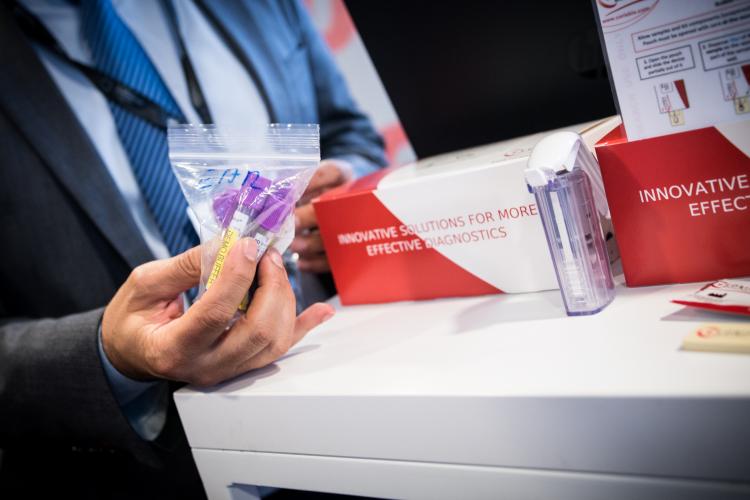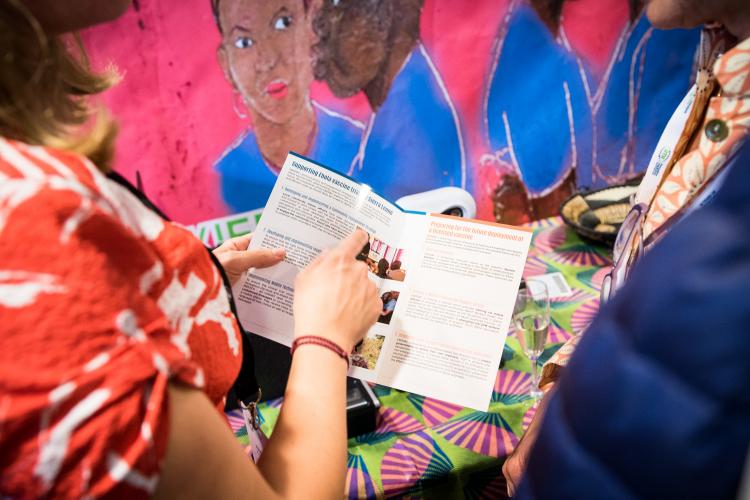Ruling out Ebola lookalikes can mean the difference between containment and catastrophe. IMI backed three bedside Ebola detection tests that work quickly with minimal equipment or training.

Telling Ebola apart from other fever-inducing infections can be difficult in the early stages, and getting it wrong can inadvertently lead to exacerbating the spread of disease. An Ebola sufferer might think they have malaria, and unknowingly spread the virus to others. If a patient arrives at a health centre with fever and other ambiguous symptoms, they run the risk of being exposed to Ebola while they await blood tests results, even if efforts are made to isolate suspected cases. Letting them go back home, on the other hand, could lead to an infected person bringing the virus into his or her family and community.
‘With people who eventually tested negative, when they were released from the treatment centre, they were stigmatised quite a lot by their local community because they had potentially been exposed to Ebola.
‘You would have patients who would go into hiding if they felt unwell because they knew they couldn’t hide their symptoms and they’d get taken to the Ebola treatment centre,’ says Edmund Newman, coordinator of the project Mofina, describing the fear and panic that surrounds suspected cases of Ebola infection. ‘With people who eventually tested negative, when they were released from the treatment centre, they were stigmatised quite a lot by their local community because they had potentially been exposed to Ebola. So not taking negative people to the Ebola treatment centre would be a massive advantage.’
If these suspected cases could be diagnosed quickly in their own home or community, the risk of spreading the infection – and the stigma – could be reduced.
A sped-up version of the gold-standard test
The idea behind the FILODIAG project was to replicate the gold-standard PCR-based test (polymerase chain reaction), but to figure out a way to return the same reliable results in a fraction of the time. PCR-based tests are highly sensitive and are typically carried out in a laboratory. They involve a machine that heats up and cools down a purified blood sample multiple times following a particular sequence (thermocycling). Thermocycling allows the amplification of the viral nucleic acids which makes them easier to detect, and while PCR tests are great for picking up tiny traces of a virus, they take time. This project developed and tested a thermocycler that supercharges the process, heating and cooling the target’s nucleic acids and returning results in about 15 minutes. The project led to the creation of a commercial product whose scope has expanded beyond Ebola.
Lab-level accuracy
Drawing on advances in automated molecular biology techniques, the Mofina project created a portable device about the size of a desktop computer that can test for all known Ebola virus strains in 75 minutes. It’s based on two existing technologies: a conventional Ebola test and the Alere q molecular diagnostics platform, already used for HIV testing, which performs nucleic acid tests on blood samples. A finger-prick blood sample is all that is needed for the test, and accuracy is similar to what can be expected in sophisticated laboratories. The test reduces the infection risk for operators, and training materials are provided with the device, meaning testing can be carried out by, for example, local healthcare workers, contact tracing teams, or Red Cross nurses. An internal battery lasts for up to eight hours, so testing can be carried out even in the midst of a power outage. The product has also proven to be a commercial success; it’s been CE marked and is already commercially available.
De-fanging the virus
The researchers in the EbolaMoDRAD project tried out different techniques for detecting Ebola infection in the blood, such as looking out for the virus itself, or looking for immune responses that would point to an infection. They pitted different methods of gene detection by isothermal amplification against each other, and settled on the best performing method. They then developed a battery-operated pipette tip extraction to single out the Ebola material so that the whole process is less dependent on electricity.
They also wanted to come up with a way to handle blood samples without creating any risk for the people who are responsible for taking, working with or transporting them. The result is a vacuum collection tube filled with an inactivation liquid that de-fangs the virus itself while keeping the genetic material stable for about five weeks, eliminating the need for a glovebox-equipped lab. Diagnosis is carried out on the spot, using the lateral flow dipstick test, which means there is no need for high-spec equipment or expertise. Using samples gathered during the 2014-2016 outbreak, the researchers were able to confirm the efficacy of the tools in Sierra Leone.

Diagnosing other viral haemorrhagic fevers
Going a step further, the EbolaMoDRAD project has been extended to expand the list of infections that can be tested for; VHFMoDRAD will develop a test that can diagnose, in a single blood sample, other viral haemorrhagic fevers like Lassa fever, Crimean Congo Hemorrhagic fever, Rift Valley fever, Marburg, Yellow fever, Dengue fever and Zika. The tests will also be validated in the field, and training courses will be set up in the west African region to teach locals how to use the tools. The project also intends to partner with an African manufacturer so that the tests can be produced locally.
More stories in the Ebola series
As Ebola rages in the DRC, the world is closer than ever to the first licensed vaccine
How do you prepare for a pandemic? by Pierre Meulien, IMI Director
Related
'We are more prepared for future outbreaks' - interview with Mofina coordinator
'We jumped into the project and we're glad we did' - interview with FILODIAG coordinator
